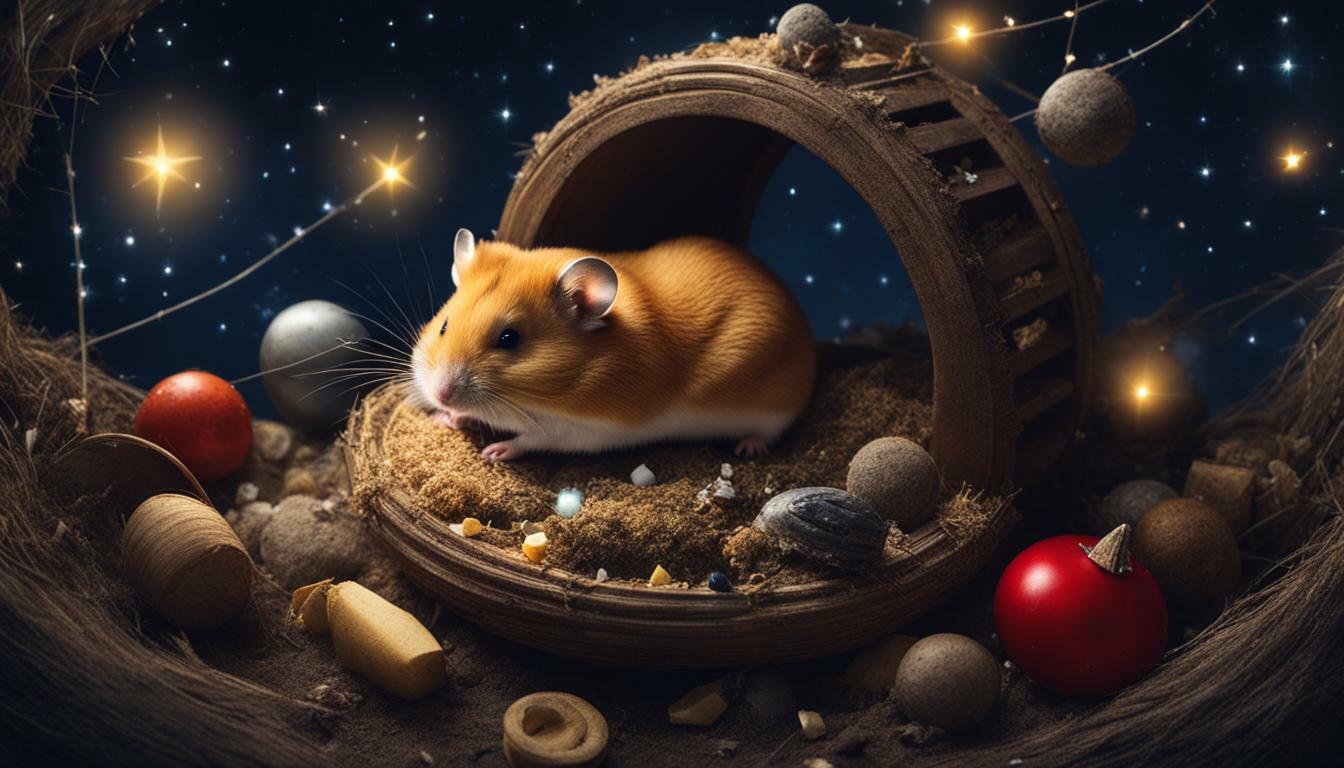If you’ve ever wondered why hamsters are nocturnal, this section will shed light on their intriguing behavior and sleep patterns. Hamsters are actually considered crepuscular, which means they are most active during dawn and dusk. This unique adaptation is influenced by their natural environment and the presence of predators.
Factual data: Hamsters are often described as nocturnal pets, but they are actually crepuscular, which means they are most active during twilight hours at dawn and dusk. This behavior is an adaptation to their natural environment and the presence of predators. Hamsters sleep during the day to avoid being preyed upon by diurnal predators, and they come out during twilight when both diurnal and nocturnal predators are less active. Hamsters have poor eyesight, so they rely on their sense of smell and hearing during these low-light periods. It is not advised to try to change a hamster’s crepuscular behavior, as it can cause stress and sickness. It is important to provide a dark and quiet environment for hamsters during their sleeping hours.
Key Takeaways:
- Hamsters are crepuscular, meaning they are most active during dawn and dusk.
- This behavior is an adaptation to their natural environment and the presence of predators.
- Hamsters sleep during the day to avoid diurnal predators and come out during twilight when predators are less active.
- Hamsters have poor eyesight and rely on their sense of smell and hearing in low-light conditions.
- It is important to respect and accommodate a hamster’s crepuscular behavior for their well-being.
Understanding Hamster Sleep Patterns
Hamsters have their own unique sleep cycle, and understanding it can help us comprehend why they are more active at night. These adorable pets are crepuscular, which means they are most active during twilight hours at dawn and dusk. This behavior is an adaptation to their natural environment and the presence of predators.
Hamsters sleep during the day to avoid being preyed upon by diurnal predators, and they come out during twilight when both diurnal and nocturnal predators are less active. With their poor eyesight, hamsters rely on their sense of smell and hearing during these low-light periods to navigate their surroundings.
To visualize a hamster’s sleep cycle, we can refer to their circadian rhythm. This internal biological clock regulates their sleep and wake patterns. While humans have a 24-hour circadian rhythm, hamsters operate on a shorter cycle of around 20-30 hours. This means their sleep-wake cycle can shift over time. For example, one day they may be more active in the evening, and the next day they may be more active in the morning.
To accommodate a hamster’s unique sleep patterns, it is important to provide them with a dark and quiet environment during their sleeping hours. This can be achieved by placing their enclosure in a quiet room or covering it with a breathable fabric that blocks out light. By creating a suitable sleep environment for your furry friend, you can ensure they get the rest they need to maintain their overall well-being.
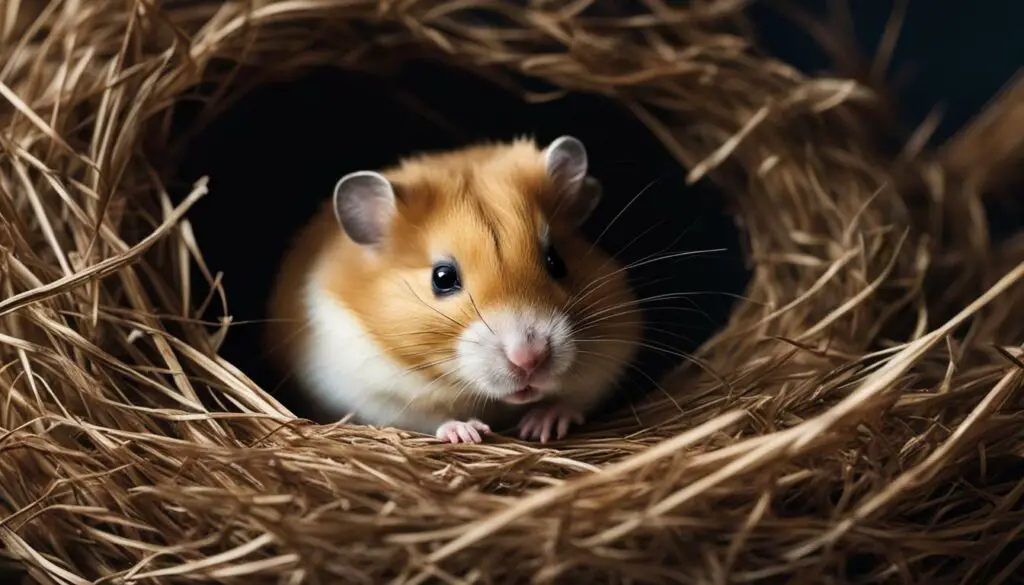
| Hamster Sleep Patterns | Characteristics |
|---|---|
| Crepuscular Behavior | Hamsters are most active during twilight hours at dawn and dusk. |
| Sleeping During the Day | To avoid predators, hamsters sleep during the day when diurnal predators are active. |
| Relying on Other Senses | Due to their poor eyesight, hamsters rely on their sense of smell and hearing during low-light periods. |
| Circadian Rhythm | Hamsters have a shorter circadian rhythm of around 20-30 hours, which can affect their sleep-wake cycle. |
| Creating a Suitable Sleep Environment | Providing a dark and quiet environment during their sleeping hours is crucial for hamsters’ well-being. |
Crepuscular Adaptation in Hamsters
Hamsters are not strictly nocturnal but rather crepuscular, meaning they are most active during the twilight hours at dawn and dusk. This behavior is an adaptation to their natural environment and the presence of predators. Hamsters sleep during the day to avoid being preyed upon by diurnal predators, and they come out during twilight when both diurnal and nocturnal predators are less active.
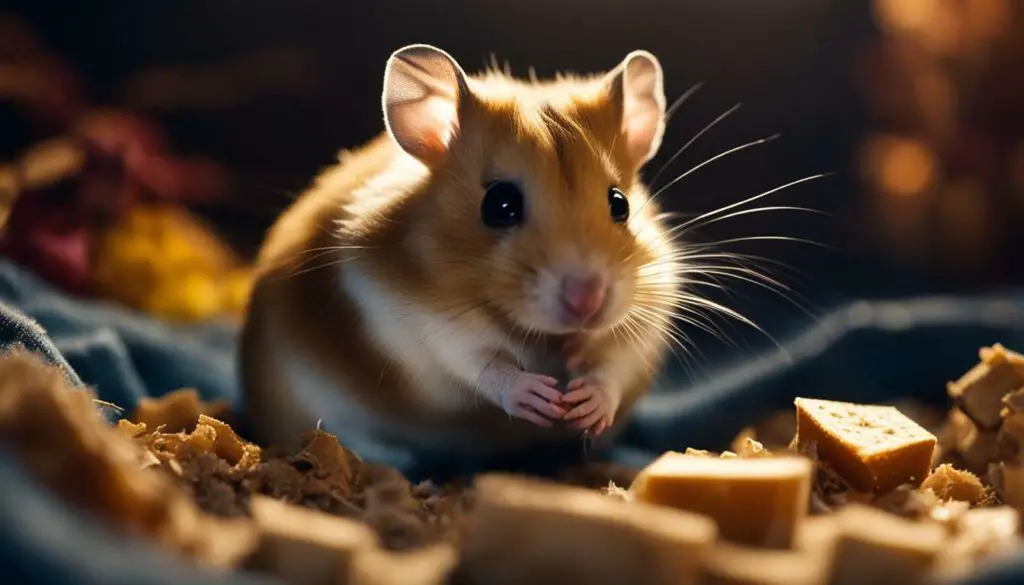
Hamsters have poor eyesight, relying instead on their sense of smell and hearing during these low-light periods. Their keen senses help them navigate and find food even in dimly lit conditions. This sensory adaptation allows them to safely explore their surroundings and locate necessary resources while minimizing the risk of predation.
It is important to note that attempting to change a hamster’s crepuscular behavior can cause stress and sickness. Their natural sleep cycle is deeply ingrained and disrupting it can lead to health issues. Providing a dark and quiet environment during their sleeping hours is essential for their well-being. This means avoiding bright lights, loud noises, and disturbances that may disrupt their restful sleep.
In summary, hamsters are crepuscular animals, adapted to be most active during twilight hours at dawn and dusk. Their behavior is a response to their natural environment and the need to avoid predators. While they may exhibit some nocturnal characteristics, it is crucial to respect their crepuscular nature and provide them with a suitable sleep environment for optimal health and well-being.
Predator Avoidance and Survival Instincts
Hamsters have evolved to be crepuscular to minimize their risk of being preyed upon by both diurnal and nocturnal predators. This behavior allows them to take advantage of low-light conditions when both types of predators are less active. By sleeping during the day and being active during twilight hours, hamsters can navigate their surroundings without attracting unwanted attention.
Hamsters, with their poor eyesight, rely on other senses to navigate and locate food during their nocturnal hours. Their keen sense of smell helps them identify potential threats and find their way back to their burrows. Additionally, their excellent hearing allows them to detect predators approaching from a distance, giving them time to escape to safety.
Interestingly, hamsters have also developed an instinct to hide away food in their burrows. This behavior serves as a survival strategy in case of scarcity and reduces their need to leave the safety of their burrows during daylight hours when predators are more active. By storing food, hamsters can minimize their exposure to potential dangers and ensure a steady supply of sustenance.
Hamsters have adapted their behavior to survive and thrive in their natural environment. Their crepuscular instincts, combined with their sensory adaptations and survival strategies, enable them to minimize the risk of being preyed upon and ensure their continued survival.
Sensory Adaptations for Low-Light Conditions
In order to navigate during low-light conditions, hamsters have developed impressive sensory adaptations. Although their eyesight is not their strongest sense, their sense of smell and hearing compensate for this limitation.
“Hamsters have an incredible sense of smell,” says Dr. Jessica Rodriguez, a wildlife biologist. “Their long whiskers help them navigate and explore their surroundings, and they can detect prey, predators, and potential mates through scent.”
Furthermore, hamsters have a remarkable ability to hear ultrasonic sounds. They can detect high-frequency noises that are inaudible to humans and many other animals. This acute hearing allows them to sense the presence of predators and remain alert even in the darkness.
By relying on their strong sense of smell and hearing, hamsters are able to maneuver through their environment and stay safe during their nocturnal activities.
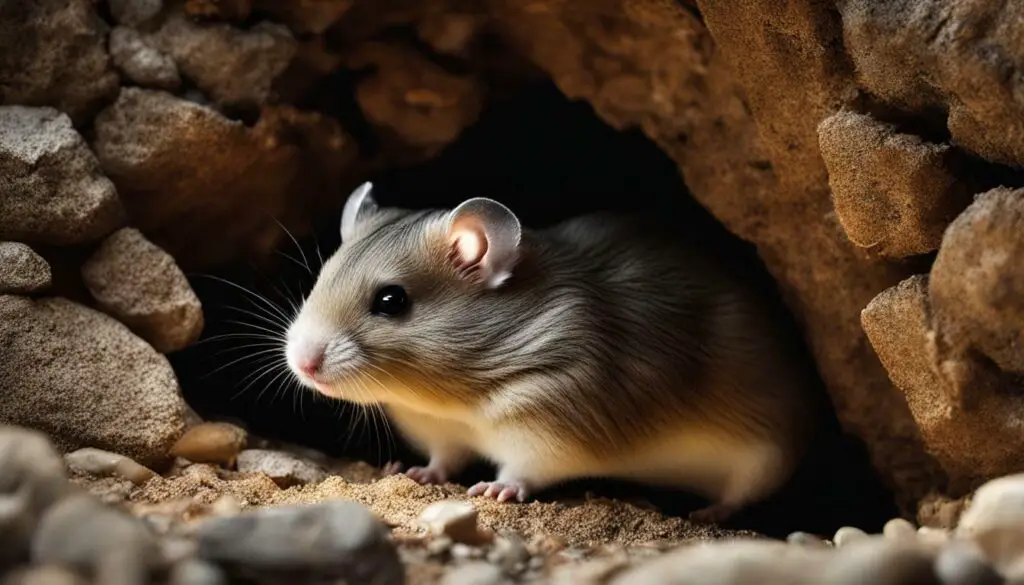
| Predator Avoidance and Survival Instincts | Sensory Adaptations for Low-Light Conditions |
|---|---|
| Hamsters are crepuscular animals, active during twilight hours when both diurnal and nocturnal predators are less active. | Hamsters have a keen sense of smell and hearing to navigate and detect potential threats during low-light periods. |
| They sleep during the day to avoid diurnal predators and come out at dusk and dawn when nocturnal predators are less active. | Their sense of smell helps them identify predators and find their way back to their burrows, while their hearing allows them to detect approaching threats. |
| Hamsters instinctively hide away food in their burrows, reducing the need to leave during daylight hours when predators are more active. | Despite their poor eyesight, hamsters rely on their sense of smell and hearing to navigate and find food in the dark. |
Sensory Adaptations for Low-Light Conditions
Due to their limited eyesight, hamsters rely heavily on their sense of smell and hearing during the twilight hours when visibility is reduced. These sensory adaptations enable them to navigate their environment, find food, and detect potential threats. Hamsters have an acute sense of smell, which allows them to identify familiar scents, locate food sources, and even detect the presence of predators. Their scent glands, located on their flanks, produce a unique scent that helps them mark their territory and communicate with other hamsters.
Hamsters also have excellent hearing, which helps them detect the subtle sounds of their surroundings. Their ears are large and sensitive, allowing them to pick up on distant noises and potential dangers. They can hear high-pitched sounds that are inaudible to humans, making them more aware of their surroundings during the low-light periods.
“Hamsters rely on their sense of smell and hearing during twilight hours when their visibility is reduced.”
To further enhance their ability to navigate in low-light conditions, hamsters have elongated whiskers, known as vibrissae, on their faces. These whiskers are incredibly sensitive and help them detect changes in their surroundings, such as the presence of objects or obstacles. By brushing against surfaces, the whiskers provide valuable information about the environment, helping hamsters avoid collisions and move with confidence.
In summary, hamsters have developed remarkable sensory adaptations to thrive in low-light conditions. Their acute sense of smell, excellent hearing, and sensitive whiskers allow them to compensate for their poor eyesight. These adaptations enable them to navigate their surroundings, communicate with other hamsters, and stay safe from potential predators during the twilight hours.
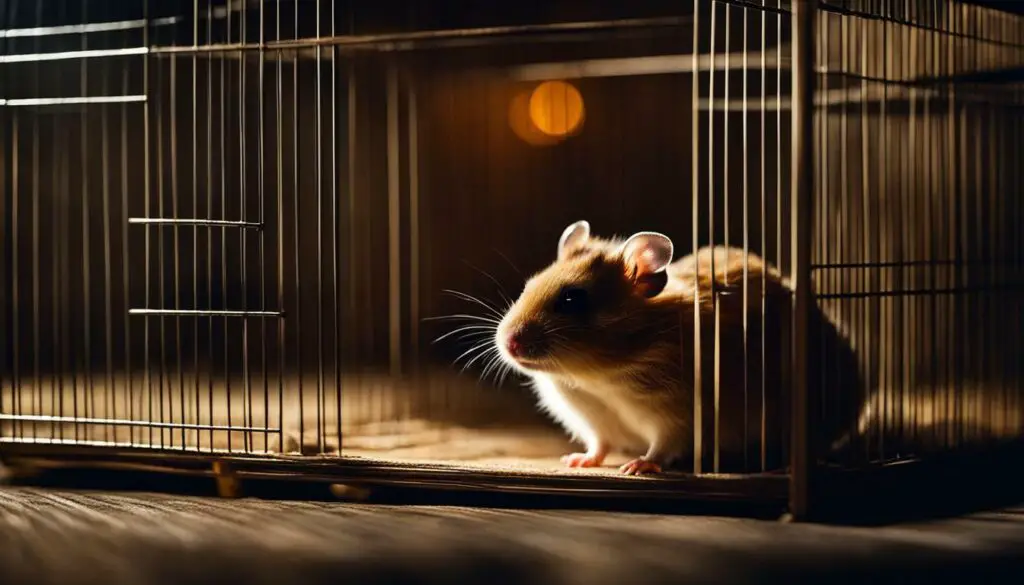
| Hamster Sensory Adaptations for Low-Light Conditions | |
|---|---|
| Sense of smell | Hamsters have an acute sense of smell, which helps them locate food sources and identify potential threats. |
| Hearing | Hamsters have excellent hearing, allowing them to detect distant sounds and potential dangers. |
| Vibrissae | Hamsters have sensitive whiskers on their faces, which help them detect changes in their surroundings and avoid obstacles. |
The Importance of Maintaining Natural Behavior
Trying to alter a hamster’s crepuscular behavior can have negative effects on their well-being, making it important to provide an environment that supports their natural sleep patterns. Hamsters have evolved to be most active during twilight hours at dawn and dusk, aligning with their instinctual behavior in the wild. This behavior is an adaptation to their natural environment and the presence of predators.
During the day, hamsters sleep to avoid being preyed upon by diurnal predators. By staying hidden and inactive, they reduce the risk of being detected. Hamsters emerge during twilight when both diurnal and nocturnal predators are less active, allowing them to forage for food and engage in their natural behaviors. This crepuscular behavior ensures their survival and helps them fulfill their innate instincts.
Hamsters have poor eyesight, relying instead on their exceptional sense of smell and hearing. During low-light periods, their heightened senses allow them to navigate their surroundings and locate food sources. Their noses and ears become their primary tools, compensating for their limited vision. By providing an environment that mimics their natural habitat, you can help your hamster thrive and feel secure.
Creating a dark and quiet sleeping environment for your hamster is crucial to their overall well-being. Avoid exposing them to bright lights or loud noises during their designated sleeping hours. This will allow them to rest undisturbed and maintain their natural sleep cycle. By respecting their crepuscular behavior and providing an optimal sleep environment, you can ensure that your hamster remains healthy and content.
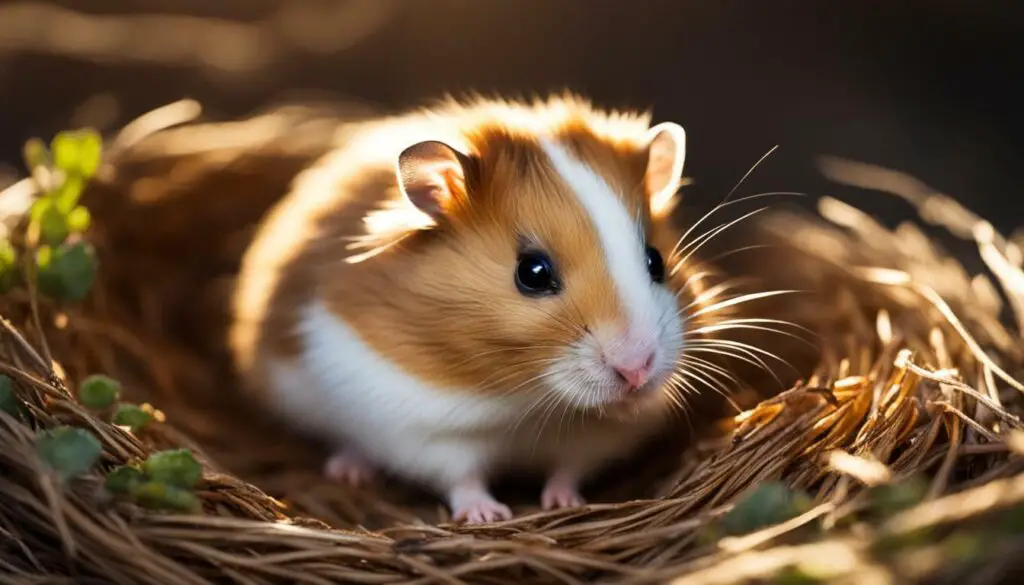
| Benefits of Maintaining Natural Behavior |
|---|
| Reduces stress and anxiety |
| Promotes natural foraging and activity |
| Enhances overall well-being |
Creating a Suitable Sleep Environment
To ensure your hamster gets the rest it needs, it is crucial to provide a dark and quiet environment during their sleeping hours. Hamsters are crepuscular animals, meaning they are most active during dawn and dusk. This natural behavior allows them to avoid predators and feel secure in their surroundings.
Start by placing your hamster’s cage in a quiet area of your home, away from any loud noises or disturbances. Avoid placing their cage near windows or areas with excessive light, as this can interfere with their sleep patterns. Covering the cage with a thin, breathable fabric can help create a dark and cozy sleeping environment for your furry friend.
| Key Points: | Benefits: |
|---|---|
| Darkness | Allows hamsters to feel safe and secure. |
| Quietness | Prevents disturbances that may disrupt their sleep. |
Additionally, consider investing in a silent exercise wheel for your hamster. Regular exercise is important for their overall well-being, but noisy wheels can disturb their sleep. Opt for a wheel specifically designed for quiet operation, ensuring your hamster can run to their heart’s content without any disruptive noises.
Remember, providing a suitable sleep environment is essential for your hamster’s health and happiness. By understanding their crepuscular nature and making a few simple adjustments, you can help ensure your nocturnal companion gets the rest they need to stay active and energetic during their waking hours.
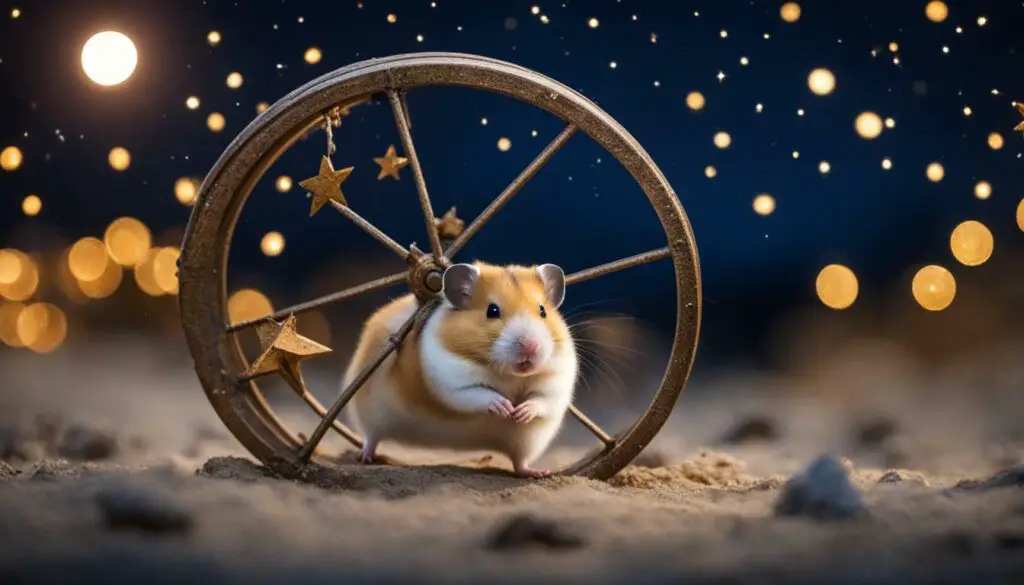
Caring for a nocturnal hamster involves understanding their unique sleep patterns and providing them with the necessary care during their active hours. These adorable creatures have adapted to a crepuscular lifestyle, being most active at dawn and dusk. To ensure the well-being of your hamster, here are some essential tips:
- Create a suitable sleep environment: Hamsters need a dark and quiet space for uninterrupted rest. Place their cage in a secluded area away from noise and bright lights. Cover the cage with a breathable fabric to create a cozy den-like atmosphere.
- Respect their sleep schedule: Avoid disturbing your hamster during their sleeping hours. They need uninterrupted rest to maintain their health and alertness. Try to schedule interactions and activities during their waking hours to minimize stress.
- Provide mental and physical stimulation: Hamsters are energetic little creatures, and it’s important to provide them with opportunities for exercise and mental stimulation. Offer toys, tunnels, and exercise wheels in their cage to keep them entertained and active.
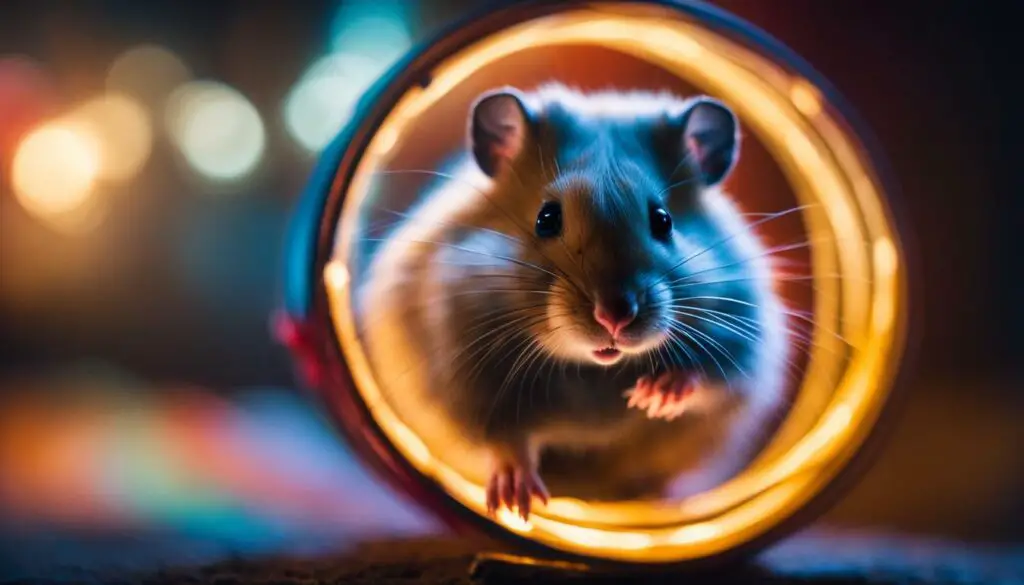
Remember, hamsters have a keen sense of smell and hearing, so they can be easily stressed by strong odors or loud sounds. Keep their environment clean and odor-free, and avoid sudden loud noises that could startle them.
Additionally, it’s crucial to provide a balanced diet for your hamster to support their overall well-being. Consult with a veterinarian or do thorough research to ensure you’re feeding them a nutritionally complete food that meets their specific dietary requirements.
In Summary
Understanding and respecting your hamster’s crepuscular nature is key to caring for them properly. Providing a suitable sleep environment, respecting their sleep schedule, and offering mental and physical stimulation will help keep your nocturnal companion happy and healthy.
Conclusion
By understanding why hamsters are nocturnal and respecting their natural sleep patterns, you can ensure a happy and healthy life for your cuddly little pet. Hamsters are not strictly nocturnal; they are actually crepuscular animals, meaning they are most active during the twilight hours at dawn and dusk.
This behavior is an adaptation to their natural environment and the presence of predators. Hamsters sleep during the day to avoid being preyed upon by diurnal predators, and they come out during twilight when both diurnal and nocturnal predators are less active. It’s their way of maximizing their chances of survival in the wild.
Hamsters have poor eyesight, so they rely on their sense of smell and hearing during these low-light periods. Their acute senses compensate for their limited vision and help them navigate their surroundings with ease. It’s fascinating to observe how they utilize their heightened senses to explore and interact with their environment.
It is important to note that attempting to change a hamster’s crepuscular behavior can cause stress and potentially lead to health issues. Instead, it’s essential to provide a dark and quiet environment for your hamster during their sleeping hours. This will help them feel secure and enable them to maintain their natural sleep patterns. By doing so, you are promoting their overall well-being and allowing them to thrive as the crepuscular creatures they are.
FAQ
Why are hamsters described as nocturnal pets?
Hamsters are often described as nocturnal because they are most active during the night.
Are hamsters truly nocturnal?
No, hamsters are actually crepuscular, which means they are most active during twilight hours at dawn and dusk.
Why are hamsters crepuscular?
Hamsters are crepuscular as an adaptation to their natural environment and the presence of predators.
Do hamsters sleep during the day?
Yes, hamsters sleep during the day to avoid being preyed upon by diurnal predators.
When are hamsters most active?
Hamsters are most active during the twilight hours at dawn and dusk.
How do hamsters cope with low-light periods?
Hamsters rely on their sense of smell and hearing during low-light periods due to their poor eyesight.
Can I change my hamster’s crepuscular behavior?
It is not advised to try to change a hamster’s crepuscular behavior as it can cause stress and sickness.
How should I create a suitable sleep environment for my hamster?
Provide a dark and quiet environment for your hamster during their sleeping hours.
How should I care for my nocturnal hamster?
Handle your hamster during their waking hours and understand their activity needs.

